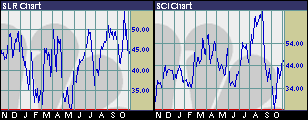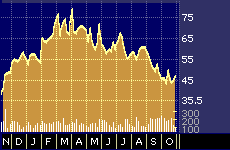
Time to Sell Solectron, Buy SCI?
Time to Sell Solectron, Buy SCI?
By Hal Plotkin
CNBC.com Silicon Valley Correspondent
Looks like it might be time to reshuffle your holdings in the highflying electronic-manufacturing services sector.
Although no financial analysts will put it quite this bluntly, Solectron Corp. {SLR} is the stock to sell. The stocks to buy: SCI Systems Inc. {SCI} and perhaps, Flextronics International Ltd. {FLEX}.
The advice is notable in that it comes from some of the same analysts who recommended buying Solectron’s stock early last summer before what they said would be a big year-end surge. They were right; Solectron’s stock shot up nearly 50% over the past six months.
But that was then and this is now.
“I think Solectron has had its move,” says J. Keith Dunne, the San Francisco-based analyst at Robertson Stephens who was one of the first to make the dead-on Solectron buy call earlier this year. For the record, Dunne still has a “buy” rating on Solectron’s stock, which he says remains a good investment for longer-term investors.
But he also says that Solectron’s pending acquisition of Asian contract manufacturer NatSteel Electronics Ltd. in a deal valued at $2.4 billion probably means the end of the big run-up in Solectron’s share price, at least over the next few quarters.
The reason: NatSteel generates most of its income by serving the margin-pressed often-cyclical personal computer market. The firm’s key customers include Apple Computer Inc. {AAPL}, which accounts for about 53% of sales, Hewlett-Packard Co. {HWP}, which accounts for 18% of sales, and International Business Machines Corp. {IBM}, which accounts for 8% of sales. All told, NatSteel generated only about 6% of its sales last year from far more desirable, higher-margin communications markets, according to Dunne’s calculations.
That is why Dunne thinks investors would be better off scooping up SCI’s shares, especially in the aftermath of the revenue and earnings warning last quarter that cut that stock’s value nearly in half.
SCI’s stock, which had more than doubled over the past 12 months, hit the skids after the company shaved its earnings and sales forecasts in September. The setback was primarily attributed to a key European set-top box customer missing a new product design window.
But like other analysts who attended SCI’s analyst day meeting on Monday, Dunne now says the company’s recent customer wins and revitalized senior management team have convinced him to move SCI’s stock back to the top of his year-end shopping list.
“What really happened is that SCI shifted some money to the back end of the year,” Dunne says.
Dunne adds that at today’s price SCI’s stock is trading at a 40% discount, compared with Solectron, based on a P/E comparison, even though both firms will soon have very similar end markets.
Chart
“I think that means SCI goes back up into the 60s [dollar range],” Dunne says.
Dunne says he left this week’s SCI analyst day meeting convinced that the company is moving in the right direction in terms of its product mix. Communications customers accounted for only 15% of SCI’s revenue in 1999. That number had grown to 25% when the company announced fiscal year 2000 year-end results on Oct. 25.

By the end of 2001, Dunne says he expects to see SCI’s more-lucrative communications accounts swell to fully 35% of sales.
Solectron, by contrast, will see its revenue from communications and networking customers fall from about 57% to 45% of total revenue after the NatSteel acquisition is complete. At the same time, Solectron’s percentage of revenue from lower margin PCs will grow from its current 16% to 27% as a consequence of the NatSteel deal.
Bill Cage, an analyst at First Union Securities in Nashville, Tenn., also sees SCI’s stock moving back up to the $60 range before long. He has a “strong buy” rating on the stock, along with a $68 12-month price target.

One-year performance of FLEX
“Over the last six months SCI has announced new programs that cumulatively exceed $3 billion,” Cage says. The First Union analyst also expects to see SCI land a new contract with Cisco Systems Inc. {CSCO} before Christmas.
Cage attributes much of the success to SCI’s recently reinvigorated senior management team, including the promotion of Bob Bradshaw to the role of president and the naming of Bruce Leasure as vice president of marketing and sales.
Bradshaw is a 20-year veteran from IBM and Leasure was formerly one of Solectron’s top account managers.
“The management team is very experienced,” Cage says. “I think it will lead to their exposure to communications expanding significantly.”
Cage adds that Flextronics’s stock looks like another strong bet at the moment. He has a $75 12-month price target on the stock, which he also rates “strong buy.”
“Flextronics is positioned to become the world’s source for wireless handsets over the next two years,” Cage says.
Cage says Flextronics and SCI will both benefit from overall growth in the contract-electronics manufacturing sector, regardless of any potential hiccups in the optical sector. According to his figures, these firms as a group should post 25% year-over-year growth for the next five years, primarily as a result of the escalating trend toward outsourced manufacturing.
“That’s why it doesn’t really matter whether optics is growing at 90% a year or at 87% a year,” Cage says. “The overall health of the [EMS] industry is stronger than we’ve ever seen it.”
Lou Miscioscia, an analyst at Lehman Brothers in New York, also tabs Flextronics and SCI as his two current top picks in the sector. “Flextronics is my growth pick, and SCI is my value play,” he says.
The Lehman analyst has “buy” ratings on both stocks, which is his firm’s highest recommendation. He sees Flextronics’s stock moving up to 55 by early summer and SCI’s shares rising to about 75 within the next year.
“Flextronics should continue to hit and exceed its top- and bottom-line numbers,” Miscioscia says. “At the same time, I think SCI’s turnaround is in process. They’ve got a whole new [management] team that brings the skills they need. Now it all comes down to execution, but they’re already getting new business and it looks like there’s more to come.”
Miscioscia says investors can get a sense of the basic strength of the contract-electronics manufacturing sector by reexamining the recent past.
“When the Internet bubble burst in March and April, the EMS stocks rallied to all-time highs,” Miscioscia says. “Now there are worries about a variety of tech sectors. But when all the dust settles, the EMS stocks will be the ones left standing. They remain the growth opportunity in technology.”


